In an era marked by rapid administrative shifts, the Social Security Administration (SSA) under President Trump has become a focal point of concern and skepticism. Despite assurances from the administration that Social Security benefits would remain untouched, recent changes hint at a troubling reality. This complication is compounded by a systematic reduction of resources and staff, causing voices of alarm to rise among experts who believe that these measures could disrupt access to essential services for millions. The ramifications of this crisis extend far beyond mere administrative inefficiencies—they threaten the very livelihoods of individuals relying on Social Security for survival.
The Paradigm Shift: Cuts and Closures
One of the most prominent shifts in the SSA is the significant reduction of workforce—the elimination of approximately 7,000 employees and the closure of six regional offices. This ‘slimming down’ of the agency aims to create what’s framed as a more efficient operational framework; however, the reality is far from comforting. As former Deputy Commissioner Jason Fichtner highlighted, such extreme measures disrupt service delivery. Long wait times on the SSA’s helplines, glitches on its website, and overcroweded field offices are clear indicators that this restructuring is leading to a slower, less responsive system.
These changes are particularly alarming for eligible Americans, especially individuals living with disabilities, who could face significant barriers in accessing their benefits. The prospect of these life-sustaining financial supports becoming more difficult to claim ends in a grim realization: the challenges may be so overwhelming that some may not survive the process before their eligibility is affirmed.
Tech Turmoil: An Ominous Code Migration
The situation grows even more precarious with ongoing plans to migrate “tens of millions of lines of code” related to the SSA’s operations. Such bureaucratic undertakings are inherently fraught with challenges, especially when pursued with accelerated urgency. Transitioning systems built on outdated programming architectures like COBOL in a matter of months raises legitimate fears about the potential for service interruptions. This approach deviates drastically from standard practices, which typically unfold over years, allowing time for thorough testing and debugging.
Experts contend that this hurried transition could severely impact current beneficiaries. The overwhelming risks inherent in such a rapid overhaul suggest a lack of due diligence and a profound misunderstanding of the complexities involved—a negligence that has tangible consequences for those most vulnerable. The assertion that the transition will enhance efficiency appears absurd in light of the mounting expert critique.
The Misplaced Priorities of DOGE
Among the myriad changes is the Department of Government Efficiency’s (DOGE) focus on eliminating fraud at the SSA. While combating fraud is undoubtedly a necessary endeavor, experts argue that this focus is misaligned with more pressing concerns regarding the agency’s functionality. Complaints of inefficiency and delays overshadow the actual threats looming over Social Security: notably, the impending depletion of the trust funds crucial for benefit disbursement.
Experts argue that reallocating resources from much-needed administrative support to fight minimal fraud only exacerbates existing challenges. As outlined by those like Romina Boccia from the Cato Institute, this misguided strategy might undermine potential legislative reforms necessary for the SSA’s survival. With projected trust fund depletion dates approaching, every action taken by the agency—including the current erratic changes—has serious implications for long-term stability.
A Crisis in Waiting?
The warnings from Fichtner, Romig, and others are a clarion call against complacency. As administrative changes continue to unfold with the potential of grave implications, it is imperative for citizens and policymakers alike to remain vigilant. The figures are stark—the Social Security trustees suggest that by 2035, benefits could face significant cuts unless Congress intervenes effectively and promptly. The projected depletion clearly illustrates that the time for panic is now—not later.
In this environment, Social Security’s administration should be viewed not merely as an administration burden, but rather as a lifeline for millions. That this lifeline is at risk due to potentially reckless efficiency-motivated changes is a stark reminder of the precariousness that often accompanies bureaucratic maneuvering. The time has come for a reassessment of priorities, for a commitment to safeguarding the stability of what so many rely upon, ensuring that the dependent population’s needs come first in the face of unsettling administrative change.

